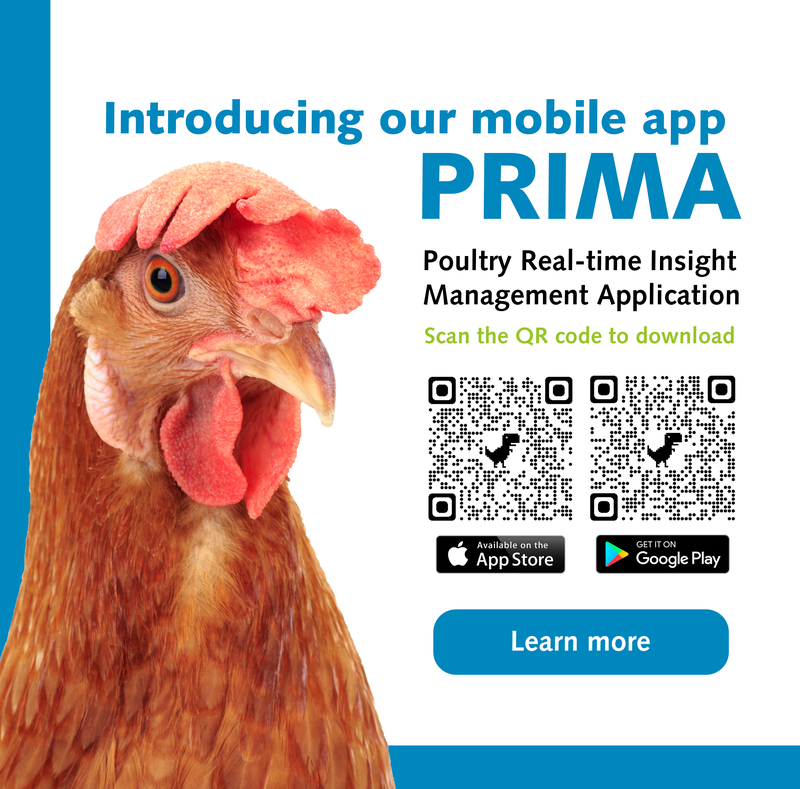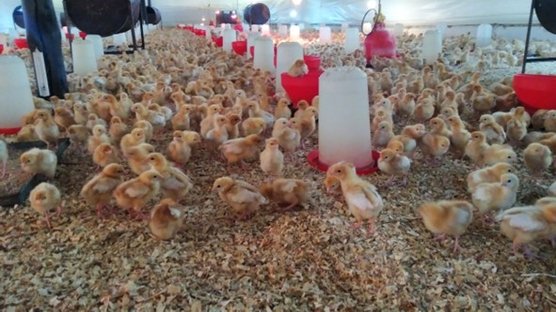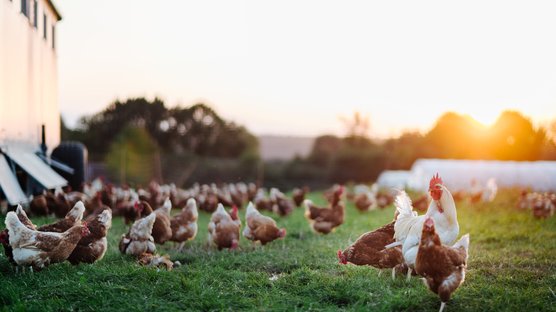
Published on Oct. 25, 2021
Improving flock results by data collection
It is no secret that insight in daily water and feed intake is essential to steer chick development and egg production. We observe that proper monitoring of water intake is too often neglected. While if water intake is reduced, feed intake will likely reduce shortly after, and consequently egg production will drop, or growth will be reduced.
To take advantage of the full genetic potential of your laying hens, it is important to respond on the early warnings that your flock is giving you. Next to that, make sure that the chicks and hens always have access to good quality drinking water and feed. Early warnings include a sudden change in water and feed intake, collecting data daily and interpreting this data on the day of collecting is crucial. Visualizing the data (making graphs) will often help to interpret the data quick and easy. Be aware, the interpretation of the results is as reliable as the quality of the data! Start with defining which data is the most important to help you managing the flock and define how often you would like to collect this parameter. And once again, make sure that the data that you collect is reliable. Tip: if you would like to compare flocks or barns, the data should be collected in a similar way. Collected data can be easily compared to other/previous flocks and breed standards (all global breed standards are available online, and in excel files upon request). Do take into account that traits can deviate from the standards, farm management, disease, rearing period and poultry diets can heavily impact the flock results.
"A sudden drop in feed intake or water intake is often one of the early warnings that something is happening."
A drop in water and feed intake can have several causes, think off stress due to vaccination, environmental stress (heat stress), a different flavor or texture of the feed, antinutritional factors or mechanical system failures. Investing in feed monitoring can be challenging and costly, for example when having no automated measuring system, you can only make a rough estimate from the feed left in the silos. However, monitoring of water intake via a water meter system is cheap and provides objective data. This data can be very well used as a first warning to indicate possible issues if monitoring and interpretation is done on a regular basis.
Chickens are sensitive for changes in feed ingredients. For example, when switching to another feed phase, or when adding new raw materials (think off raw materials which were not used before, or as well as a new harvest). Also, sudden increases of currently used raw materials in chicken diets can impact the feed intake. Chickens are not only sensitive to the amount of feed ingredients, but especially for quality of the feed. Moults, fat rancidity or too high calcium levels have a big impact on feed quality. Too drastic and too sudden changes in diets, or reduced quality of feed ingredients can directly result in reduced feed intake.
Laying hens are very sensitive to feed structure, it is advised to use the same feed structure during the rearing period (note: from 5 weeks onwards) as fed during the laying phase. To improve the knowledge about what you are feeding to your birds, it is important to check the feed structure in the feeders. Why at the feeders? Each transport, like transportation from the feed mill to the silo, or from the silo to the feeders, can decrease the feed structure quality and cause segregation of the feed. This should be taken into account when defining optimal feed structure quality.
Keep in mind that a sudden increase in feed or water intake might be caused by an operational issue. An increase in water intake can be related with a suboptimal barn climate or with a leak in the water supply. Also broken feed hoppers, or broken feed chains can be detected by investigating these sudden drops.
There are more traits that can be easily tracked and traced. Think of regular body weight measurements that can be taken during both the rearing (weekly) and production (monthly) periods. Focus and steering timely on body weight will help to steer the flocks’ future egg laying performance. At the onset of lay, it is key to stimulate body weight development. The body weight should be stable from around 35 weeks onwards as this helps to prevent the laying hens from fattening. To get a reliable body weight monitoring, it is important to measure the chicks from day-old till 30 weeks of age once a week, followed by monthly measurements from 30 weeks onwards. Make sure you take a representative sample size, floor housed chicks and laying hens can easily by measured via an automatic scale, 24/7 registering data, or by catching. For cage housed birds, identify few cages well distributed across the barn, and follow the chickens inside those cages during their lifetime.

Collecting data on a frequent basis and visualizing helps egg producers to easy monitor flock performance, like in this example of ISA Brown laying hens kept in a cage-free Housing system
Changes in egg weight are good indicators for the health, welfare, management and for sure nutrition. Sudden reductions in egg size should be considered as an early alert. Obviously, egg size monitoring requires a well-defined approach: focus on the same time of the day, and the same nests or egg belts. Today’s egg grading machines do offer more recording options, which can be very well used in monitoring egg weight and egg quality. Also, the egg grading reports from the egg packers can provide loads of valuable information.
Depending on the size of the silo and the daily amount of feed being used, new feed is being delivered on a regular basis. As a reference it is good to collect several feed samples of every batch, especially when you suspect that the feed is causing reduced flock performance. Tip: if you would like to collect a feed sample, make sure you that you take a representative feed sample from at least 500 grams. To get a better understanding of feed quality, different analyses are available to determine both the physical and the chemical quality. Physical quality of mash feed can be checked via a feed sieve analysis. General chemical analyses consist of NIRS or wet chemistry analysis, this can be used for individual raw materials or for complete chicken feed. Depending on the prevalence, raw materials can be analyzed for harmful and toxic substances, like mycotoxins or salmonella. Depending on specific symptoms of the flock, you might consider performing additional analyses: like vitamin analysis, mineral analysis, or amino acid analysis. Keep in mind it is only useful to perform some laboratory analysis if you can compare the values with the formulated values.
In the ideal world, you would be able to capture data on the individual level and manage each chicken to her individual needs. But as we are dealing in the egg and poultry sector with ever-growing flock sizes this remains rather challenging. But developments seem to be on their way as applied research is being done on individual feeding stations for laying hens. The above article shows that already on flock level you can generate a lot of data. Improving flock data collection on a daily or weekly basis and making this data visual will help you in better understanding what your flock is trying to tell you. Our technical experts are more than willing to help with interpreting the data and identify the challenges the flock is facing and in providing solutions.
Near-infrared spectroscopy (NIRS) describes a physical-optical analysis method based on spectroscopy in the range of short-wave infrared light. The method originally comes from the medical sector but has been used in agriculture for many years. For analysis, the feed sample is irradiated with near infrared light. With the help of reflection, the NIRS sensor can detect the ingredients based on the difference between irradiated and reflected light.




